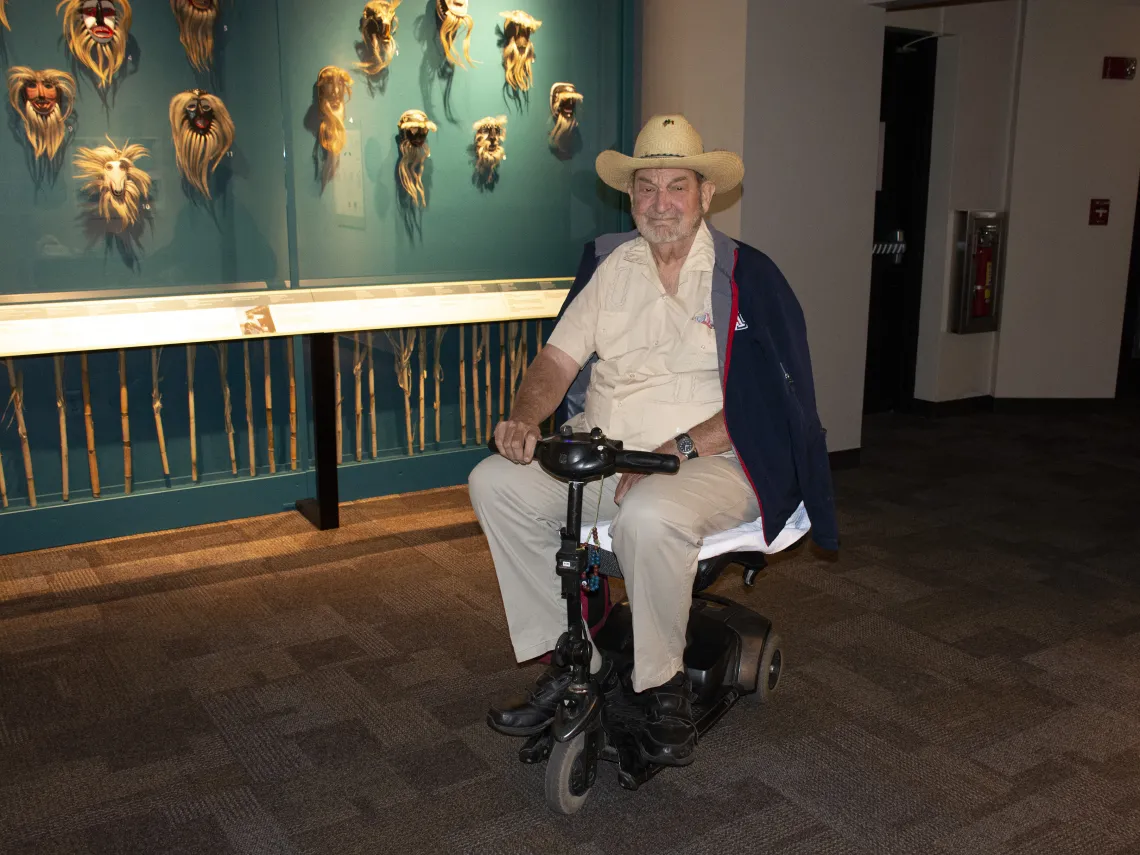
Dr. James S. Griffith, known affectionately as Big Jim
The James S. Griffith Collection of Mayo and Yoeme Pascola Masks
In places around the world and since a long time ago, masks are a part of and medium for human expression and communication. As a material representation of the magical and supernatural world, masks are used everywhere in a wide range of ceremonies, festivities, and particular forms of entertainment; Mexican masks are no exception.
Between 1965 and 1966, James S. Griffith—an anthropologist graduate student at the University of Arizona—carried out extensive research among the Mayo Indians in southern Sonora, Mexico. When he set foot in the region, he came with an ambitious research project: the description and study of the diverse masks used by Indian and mestizo communities in Sonora, Sinaloa, Nayarit, Durango, and Chihuahua in Mexico and the American Southwest. Shortly after arriving, Griffith realized the magnitude of the project and decided to concentrate only on the Mayo area focusing on pascola masks specifically (Griffith 1967a).
Over the course of these two years, Griffith visited several Mayo communities in both the Río Mayo and the Río Fuerte regions, talked to the elders, observed their festivities and dances, and collected a considerable number of pascola masks and related paraphernalia used in the pascola dances. He also undertook preliminary research along the middle Río Yaqui collecting some Névome Indian masks and in the Yoeme communities of the Yaqui Valley. With the information he collected, Griffith wrote “Rio Mayo Pascola Masks: A Study in Style”—the thesis granted him the Master of Arts degree from the University of Arizona in 1967 and was followed by several other publications on the topic (Griffith 1967a, b, 1972, 1988; Griffith and Molina 1980).
In Mexico, masks form part of a strong tradition of artesanía, or traditional folk art manufacture and among other crafts and ceremonial objects continue their role as ritual artifact throughout contemporary Mexico. Like many other ceremonial crafts, most masks reflect a blending between indigenous traditions and Catholic influences that originated with Spanish, European, and even African traditions. Yet, different regions make and use masks in distinctly characteristic ways.
Today, masks may be found mostly in areas or communities with substantial indigenous populations, such as in southern, central, and northwestern Mexico (Esser 1988; Griffith 1967b; Pomar 1988). There, embedded in communal ceremonies and traditional festivities that are performed year after year, masks form an important component of maintaining an annual agricultural calendar and fiesta cycle. Ceremonies that are intended to ensure community welfare, prosperity, identity, and unity among its members involve masks. Ranging from human to animal, the historical, hysterical, and supernatural figures, masks take on many shapes and forms.
Masks are typically made by specialists, mostly men, although increasingly women carve masks as well.
On many occasions, mask makers are also dancers who not only make their own masks, but make masks for the rest of the dancers or the community. These expressive and beautiful pieces of powerful art and artifact show their maker’s ingenious exploitation and combination of local materials and resources. Makers also use a wide range of materials to decorate a mask: common materials include paint, stucco, paper, leather, copper, hair, glass and plastic beads, shells, mirrors, feathers, and aluminum, whereas semi-precious stones, such as turquoise and pyrite are often used in mosaics. On rare occasions highly-valued material, such as gold and silver, may be included in the design (Esser 1988; Griffith 1967a, 1972; Pomar 1988). Whatever material the maker uses in the mask, however, it is sure to represent the ingenuity of its creator as well as the material communication of a cultural body of traditions and beliefs of a particular community.
Of course, a mask by itself merely represents a partial image and may even look to the uninitiated like an inert and cold object. In order to fully understand any mask, it must naturally be complemented by its dancer in the festivity or ceremony for which the mask was originally created. Thus, the spectator may see it (Pomar 1988). We now invite you to meet the pascola masks and their makers from the Mayo Indian communities of Northwest Mexico as collected by ‘Big Jim’ Griffith.
About James S. Griffith
Griffith has lived in southern Arizona and studied its people, places and cultures for more than four decades. Known affectionately as “Big Jim,” he received his Ph.D. from the University of Arizona in Anthropology in 1973. He and his wife Loma, co-founded Tucson Meet Yourself, a celebration of Tucson’s multicultural population in 1974. The event takes place annually in October at El Presidio Park.
In 1979, Griffith became director of the Southwest Folklore Center at the University of Arizona Library. After his retirement a few years ago, Big Jim became a research associate at the Southwest Center on the University of Arizona campus. He is recognized as one of the foremost folklorists in the United States.
Griffith is the author of several books and articles including Southern Arizona Folk Arts (UA Press 1988), Hecho a Mano: The Traditional Arts of Tucson’s Mexican American Community (UA Press 2000), Saints of the Southwest (Rio Nuevo Press 2000), Beliefs and Holy Places: A Spiritual Geography of the Pimeria Alta (UA Press 2002), and Saints, Statues, and Stories (UA Press 2019). In addition, he was a frequent contributor to Arizona Illustrated television news program (Channel KUAT), a PBS affiliate at the University of Arizona.





